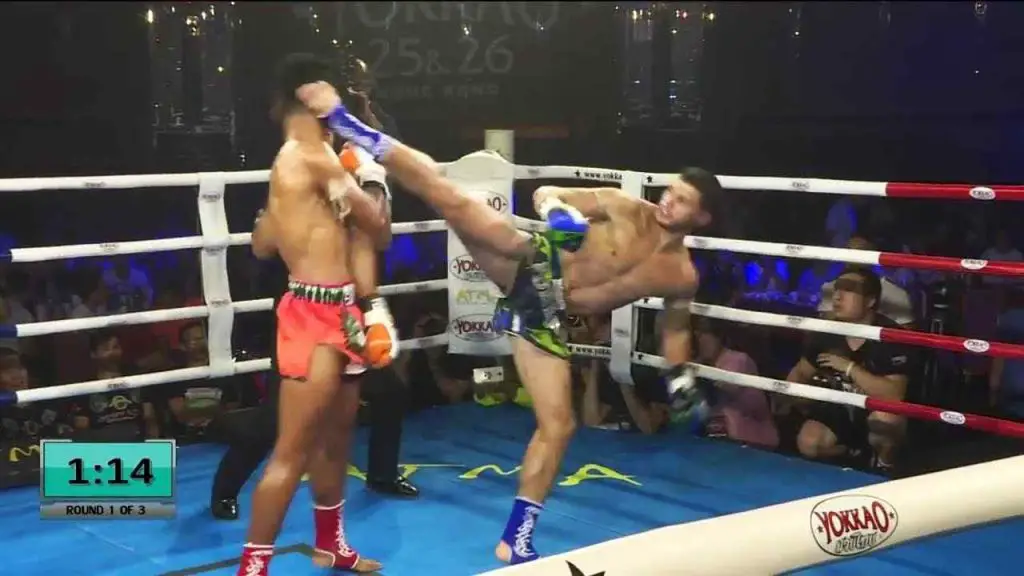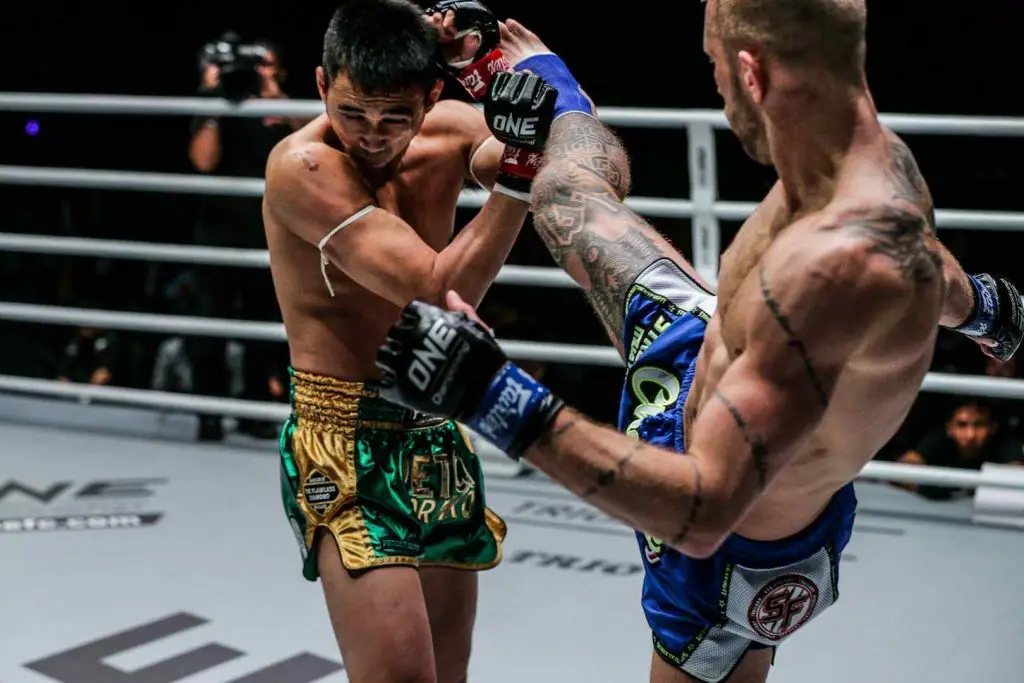Muay Thai is one of the traditional martial arts. It is one of the best hand-to-hand combat fighting styles. This fighting style is usually used in UFC fights, and back then, it was used by the people of Thailand to defend the Kingdom in the thirteenth century. Today, the Muay Thai combat style has grown into a sport and is loved by every country in the world.
The techniques of Muay Thai are divided into three categories which are as follows:
- Defense
- Attack
- Counter
Muay Thai demands a lot of practice, drilling the techniques repeatedly until they are ingrained in muscle memory. Learning the key stance and movement in Muay Thai is the first step. The body is kept in an upright position with the chin tucked in, the hands in a guard stance to protect the head, and the feet are kept about shoulder-width away.
Generally, there are 2 most common categories of Muay kicks. However, there are ten other types of Muay Thai kicks that are named by the use of the Thai language and are acknowledged as Muay Thai kicks within the straight and roundhouse forms of Muay Thai kicks.
The ten different kinds of Thai kicks that you need to know are as follow:
- Muay Thai Kick (Roundhouse)
- Straight Foot Kick
- Diagonal Kick
- Side Kick
- Slapping Foot Push
- Axe Kick
- Downward Kick (Roundhouse)
- Jumping Kick
- Spinning Round Kick
- Straight Kick
So these are the ten types of Muay Thai Kicks that are most common. Now let’s take a look at each type in detail.
Also read: Best Muay Thai Pads
1. Muay Thai Kick (Roundhouse)
The Muay Thai kick (roundhouse) is undoubtedly the most well-known and widely used type of kick in the sport. This kick, often known as the ‘Round Kick’ in Mixed Martial Arts and kickboxing, can be launched from the back or from the front.
This is a hard kick that is usually aimed to strike the leg of the opponent, head, or midsection with the shin. In this way, it gives massive damage to your opponent.
The Muay Thai kick usually hits with the help of the shin and involves proper hip mobility and body movement to generate strength. While round kicks of other martial arts generally strike with the foot or instep, this round kick is one of the powerful kicks among other martial arts round kicks.
2. Straight Foot Jab:
The straight foot jab is a good way to catch your opponent off guard, put them off balance, or counter their strikes as they get closer to throwing them. The straight foot jab, also known as the teep trong, is a ‘long’ technique comparable to the boxing jab.
This kick, also known as the teep, is one of the simplest yet crucial attacks to master and defend against.
It’s a lengthy weapon that can be used to keep your opponent at a safe distance and prevent them from closing in on you.
The target is usually the midsection of your opponent. There must be enough space between you and your opponent for the teep to fill the gap.
In fact, the leg teep is one of your longest weapons, and if used properly, the Muay Thai push kick can seriously injure your opponent while also taking their breath away.
3. Diagonal Kick

The diagonal kick is a rapid upward angling kick with the shin that is aimed at the opponent’s lower rib cage.
The diagonal kick, also known as tae Chiang, is a fast and effective technique that involves a 45-degree angle from the ground to the target. If used properly, this kick can also give you an advantage in striking your opponent in a better and effective way.
4. Side Kick
The side kick of Muay Thai is the same as the side kick of Karate and some other striking martial arts like taekwondo. This sidekick is also known as Te Tad.
Like other sidekick kinds, the Muay Thai sidekick includes chambering the leg that is used for kicking before throwing the kick in a forceful thrusting action at the target. The sidekick of Muay Thai can be targeted at a variety of targets like the Muay Thai round kick. It can also be struck by using either the front or back leg.
The primary difference is that in Muay Thai, the other leg takes a forward step before throwing the sidekick through the leg that is used for kicking. In Karate, ‘chambering’ the kick generates greater power and thrust than marching forward to create thrust and power.
5. Slapping Foot Push
This is also known as teep top. This kick requires lowering the striking knee and hitting the aim by your foot with a swift leg extension. The upper side of the foot is typically used; however, this method can also be used to hit the opponent with the entire foot.
This kick could be used in a defensive way to keep your opponent away from you or offensively to throw them off balance and force them backwards. This kick is somehow significant in defense. You can defend yourself with this kick at the same time strike the opponent.
6. Axe Kick
The Axe Kick of Muay Thai is also known as Tae Khao. Muay Thai’s axe kick is aimed towards the opponent’s head, face, and shoulders.
The opponent’s forehead, face, nose, and shoulder are the targets. The kick requires the striking leg to remain straight and the kick to be driven into downward direction directly onto the target. Muay Thai is a fantastic sport. Saenchai is recognized for his efficient use of the axe kick of Muay Thai, which he can land due to his good leg mobility and flexibility.
Muay Thai is a Thai martial art. The axe kick of Muay Thai is rarely used since it exposes the kicker to being pulled off the upright leg or rapidly countered while delivering the kick.
7. Downward Kick (Roundhouse)
The Downward Kick (Roundhouse) also has another name which is Brazilian kick. The downward kick of Muay Thai is also a type of Karate with some other name. Due to the hooking effect of one of your kicking legs on the opponent when delivering the kick in a downward direction, it’s also known as the “hook kick.”
The movement is similar to a regular roundhouse kick, except the striking leg must be raised higher and directed down. To twist the hip forward and obtain that hooking movement, you’ll need good hip motion.
Whenever you see that your competitor is bending down in a minor posture, you can use the downward kick. Alternatively, if you have good flexibility, you can perform a downward kick from an upright posture against a standing opponent, going up and above the guard and landing on the head or the area near the neck.
8. Jumping Kick

The jumping kick is also known as kradot teep. Due to the jump’s elevation, more power can be generated into the high position, which can then be directed at upper targets.
This kick covers the opponent’s facial area and the upper area of his/her chest. Raising the lead leg as you deliver a regular leading straight kick and hopping off the back leg to put down the straight jumping kick, which can easily knock your competitor down if performed effectively, is a wonderful deceiving technique.
It is also a good type of Thai Muay kick in deceiving the opponent by showing something else and the strike with something unpredicted.
9. Spinning Kick
The spinning kick is also known as tae klap lang. The spinning kick is not only visually appealing, but it is extremely effective and deadly. It could be used in a defensive manner whenever you retreat or in an offensive way whenever you track down your rival.
It’s mostly done with the back leg, and it entails turning your back on your opponent to build the necessary thrust in a spinning act that transfers enough power to the striking leg.
The opponent’s upper chest area and head are normally the aims of this kick. This kick demands good hip motion, leg flexibility, all of which can be improved with practice.
10. Straight Kick
The straight kick is also known as tae trong. The straight front kick is a rapid upward movement kick that strikes with the toes or top of the foot instead of the sole of the foot. It’s usually directed at your opponent’s upper body, especially the facial area.
This kick also has a name in Japanese as Mae Geri and is used in Karate. This kick is useful in striking the opponent on the face. After that strike, the opponent takes some time to come to his/her senses. So you get enough time to defeat him with a single blow.
Also read: Best Muay Thai Shin Guards
Final Thoughts
So that’s everything that you need to know about the ten types of Muay Thai kicks. We’ve tried our best to cover every kick in detail. Still, if something is missing, feel free to leave a comment below. We would be happy to get some new suggestions and ideas.
